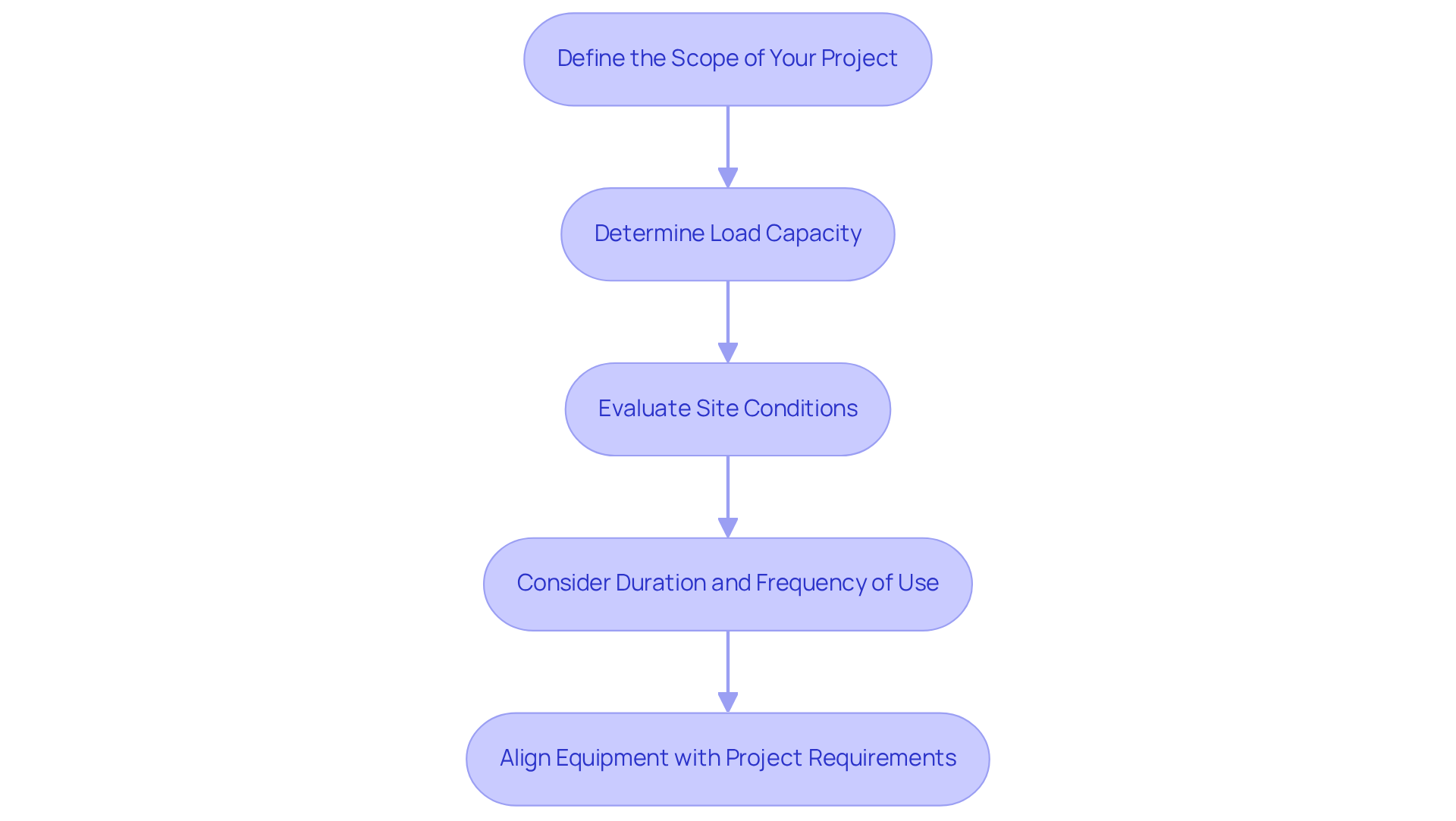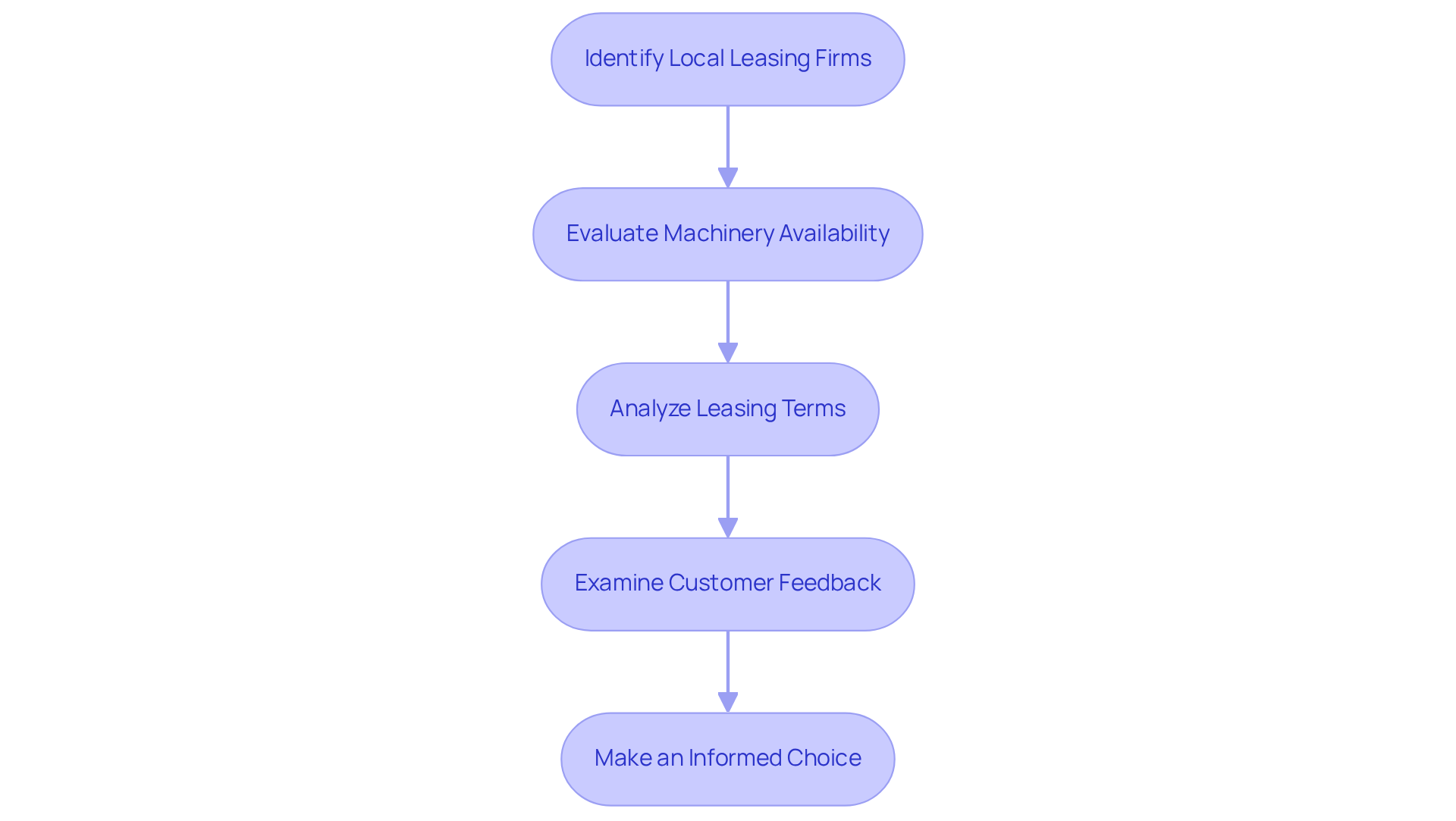Overview
To effectively rent a front end loader, it is essential to:
- Define the project scope
- Assess load capacity
- Evaluate site conditions
- Consider the duration of use
These critical steps can lead to significant cost savings. Understanding these factors, coupled with thorough research on average rental costs and additional expenses, empowers you to create an informed budget. This strategic approach not only facilitates effective selection of leasing options but also ensures that they are tailored to meet specific project needs.
Key Highlights:
- Define the project scope to outline specific tasks and assess the area size and material types.
- Determine load capacity by evaluating the weight and volume of materials to select appropriate equipment.
- Evaluate site conditions, considering terrain and obstacles to ensure optimal equipment performance.
- Assess duration and frequency of use to influence leasing choices and budget, potentially saving 30-50% on ownership costs.
- Research average rental costs for front-end loaders, with daily rates starting around $762 and monthly costs averaging $6,762.
- Consider additional costs such as delivery fees, insurance, and fuel when budgeting for equipment rental.
- Establish a clear budget based on gathered leasing information and potential extra expenses to avoid financial strain.
- Search for deals and discounts from leasing firms to enhance cost-effectiveness.
- Identify local leasing firms and confirm the availability of specific front-end models needed for the project.
- Analyse leasing terms, focusing on duration, payment terms, and penalties for late returns.
- Examine customer feedback to gauge reliability and service quality of leasing companies.
- Review the lease agreement thoroughly to ensure all terms are acceptable before finalising.
- Confirm delivery details with the leasing company and prepare the job site for equipment arrival.
- Inspect the equipment upon delivery for any damage and verify it meets specifications before signing.
Introduction
Navigating the complexities of construction projects hinges on the effective use of heavy machinery, particularly front-end loaders. Renting this essential equipment not only streamlines operations but also leads to significant cost savings.
With numerous options and considerations available, how can one ensure the best choice for their specific needs? This guide will outline the steps to determine the appropriate rental strategy, helping you maximize efficiency while minimizing expenses.
Identify Your Project Requirements
-
Define the Scope of Your Project: Begin by outlining the specific tasks for which you require front-end equipment, such as moving materials, grading, or excavation. Assess the size of the area you will be working in and the types of materials you will handle. A clear scope sets the foundation for effective equipment selection.
-
Determine Load Capacity: Evaluate the weight and volume of the materials you will be moving. This assessment is crucial for determining the appropriate bucket size and load capacity for your front-end machinery. Confirming the weight capacity of the equipment is essential to meet project requirements, as overloading can lead to costly repairs.
-
Evaluate Site Conditions: Consider the terrain and any obstacles present on the job site. If you are operating in confined spaces or on uneven ground, a more compact model may be necessary. Understanding site conditions ensures optimal equipment performance.
-
Consider Duration and Frequency of Use: Assess how long you will need the equipment and whether this is a one-time project or part of a recurring task. This evaluation influences your leasing choice and budget. Understanding how much to rent a front end loader can save companies 30-50% of total ownership costs, making it a financially savvy option.
By meticulously defining these aspects and recognizing the adaptability and competitive pricing offered by EZ Machinery Leasing, you can ensure that your front-end excavator hire aligns seamlessly with your project requirements, while also considering how much to rent a front end loader, ultimately leading to a successful outcome.

Assess Rental Costs and Budget
-
Begin by researching how much to rent a front end loader by investigating the average lease prices for front-end machines in your area. EZ Equipment Rental stands out with competitive pricing, featuring daily fees starting at approximately $762, weekly charges averaging $2,415, and a typical monthly cost for a wheel loader in Dallas, TX, at $6,762. Grasping these figures is essential for gauging how much to rent a front end loader and making informed decisions.
-
Understand Additional Costs: It is imperative to consider potential extra charges that may affect your overall leasing budget. Common additional costs include delivery fees, insurance, fuel expenses, and any necessary attachments. For instance, delivery charges can vary significantly based on distance, while insurance is crucial for protecting your investment throughout the leasing period. Notably, the most affordable wheel loader hire in Dallas, TX, provides insight into how much to rent a front end loader, as it can be reserved for $550, reflecting the lower end of the leasing market.
-
Set a Budget: After gathering leasing rate information and understanding additional expenses, establish a clear budget for your lease. Determine your spending limits on a daily, weekly, or monthly basis, including those extra expenses. This proactive strategy will help you avoid unexpected financial strain during your project.
-
Search for Deals: Many leasing firms, including EZ Machinery Hire, offer discounts for extended leasing periods or online bookings. Always ask about available promotions or loyalty programs that could lower your overall costs. As Josh Nickell, Vice President of the American Rental Association, emphasizes, planning and analytics are vital in equipment leasing. Seizing these opportunities can lead to significant savings, enhancing the cost-effectiveness of your experience. Additionally, consider the flexibility in leasing duration (daily, weekly, monthly) that EZ Tool Hire offers, which can cater to your specific project needs. Lastly, remember that EZ Tool Leasing's experienced team is prepared to assist you throughout the leasing process, ensuring you make the best decisions for your project.

Compare Rental Options and Providers
-
Identify Local Leasing Firms: Start by compiling a comprehensive list of leasing companies in your area, including notable names such as EZ Tool Leasing, United Rentals, and Sunbelt Rentals. This foundational step sets the stage for your equipment rental journey.
-
Evaluate Machinery Availability: Confirm the availability of the specific front-end models you need for your project. It’s crucial to ensure that the leasing company can provide the right equipment within your project timeline. For instance, EZ Equipment Leasing provides a diverse selection of front-end loader models, allowing customers to understand how much to rent a front end loader to effectively meet the strong demand for earthmoving machinery in Texas.
-
Analyze Leasing Terms: Carefully review the leasing agreements from different providers. Focus on key aspects such as lease duration, payment terms, and any penalties associated with late returns. EZ Equipment Rental stands out for its competitive pricing and flexible leasing conditions, which can help you determine how much to rent a front end loader while effectively managing your budget.
-
Examine Customer Feedback: Seek out customer reviews regarding the leasing companies you are considering. This feedback is invaluable as it sheds light on their reliability and the quality of customer service. With 47% of leasing firms reporting an increase in equipment rented to contractors, understanding customer satisfaction is vital for making an informed choice.

Finalize Rental Agreement and Prepare for Delivery
-
Examine the Lease Agreement: It is essential to thoroughly read through the lease agreement to ensure that all terms are acceptable. Pay close attention to the lease duration, costs, and responsibilities for upkeep and damages, as these factors are critical to your rental experience.
-
Confirm Delivery Details: Coordinate effectively with the leasing company regarding the delivery date and time. Ensure that a responsible individual will be available to receive the equipment, as this step is vital for a smooth rental process.
-
Prepare the Job Site: Clear the area designated for the front-end machinery. It is important to ensure that the site is accessible for delivery, with no obstacles that could hinder the equipment's arrival. For example, consider marking out the delivery path and ensuring that any overhead obstructions are either removed or noted to facilitate a seamless delivery.
-
Inspect the Equipment Upon Arrival: Upon the delivery of the front-end loader, conduct a thorough inspection for any visible damage and verify that it meets your specifications before signing off on the rental. According to the European Rental Association, effective delivery coordination is crucial for minimizing delays and ensuring that project timelines are met.

Conclusion
Renting a front end loader requires a systematic approach that can streamline the process and ensure optimal results for any construction project. By clearly defining project requirements, assessing rental costs, comparing options, and finalizing agreements, one can navigate the complexities of equipment rental with confidence.
Key insights emphasize the necessity of:
- Outlining specific project tasks
- Evaluating load capacities
- Understanding site conditions
Furthermore, recognizing the financial implications of rental agreements and exploring various leasing options can significantly influence the overall success of the project. Engaging with reputable rental companies like EZ Machinery Leasing not only provides competitive pricing but also valuable guidance throughout the rental process.
Ultimately, effective rental of a front end loader transcends merely securing equipment; it revolves around making informed decisions that align with project goals and budget constraints. By taking the time to assess needs and explore available options, project managers can optimize their resources, ensuring that their construction endeavors are both efficient and cost-effective.
Frequently Asked Questions
What should I do first when identifying project requirements for front-end equipment?
Begin by outlining the specific tasks for which you require the equipment, such as moving materials, grading, or excavation, and assess the size of the area and types of materials involved.
Why is it important to determine load capacity?
Evaluating the weight and volume of the materials you will be moving is crucial for determining the appropriate bucket size and load capacity for your machinery, as overloading can lead to costly repairs.
How do site conditions affect equipment selection?
Site conditions, such as terrain and obstacles, influence the choice of equipment. For example, if working in confined spaces or on uneven ground, a more compact model may be necessary for optimal performance.
What factors should I consider regarding the duration and frequency of equipment use?
Assess how long you will need the equipment and whether the project is a one-time task or recurring. This evaluation will influence your leasing choice and budget.
How can renting a front-end loader be financially beneficial?
Understanding how much to rent a front-end loader can save companies 30-50% of total ownership costs, making it a financially savvy option compared to purchasing equipment outright.
What advantages does EZ Machinery Leasing offer?
EZ Machinery Leasing provides adaptability and competitive pricing, ensuring that your front-end excavator hire aligns with your project requirements effectively.




